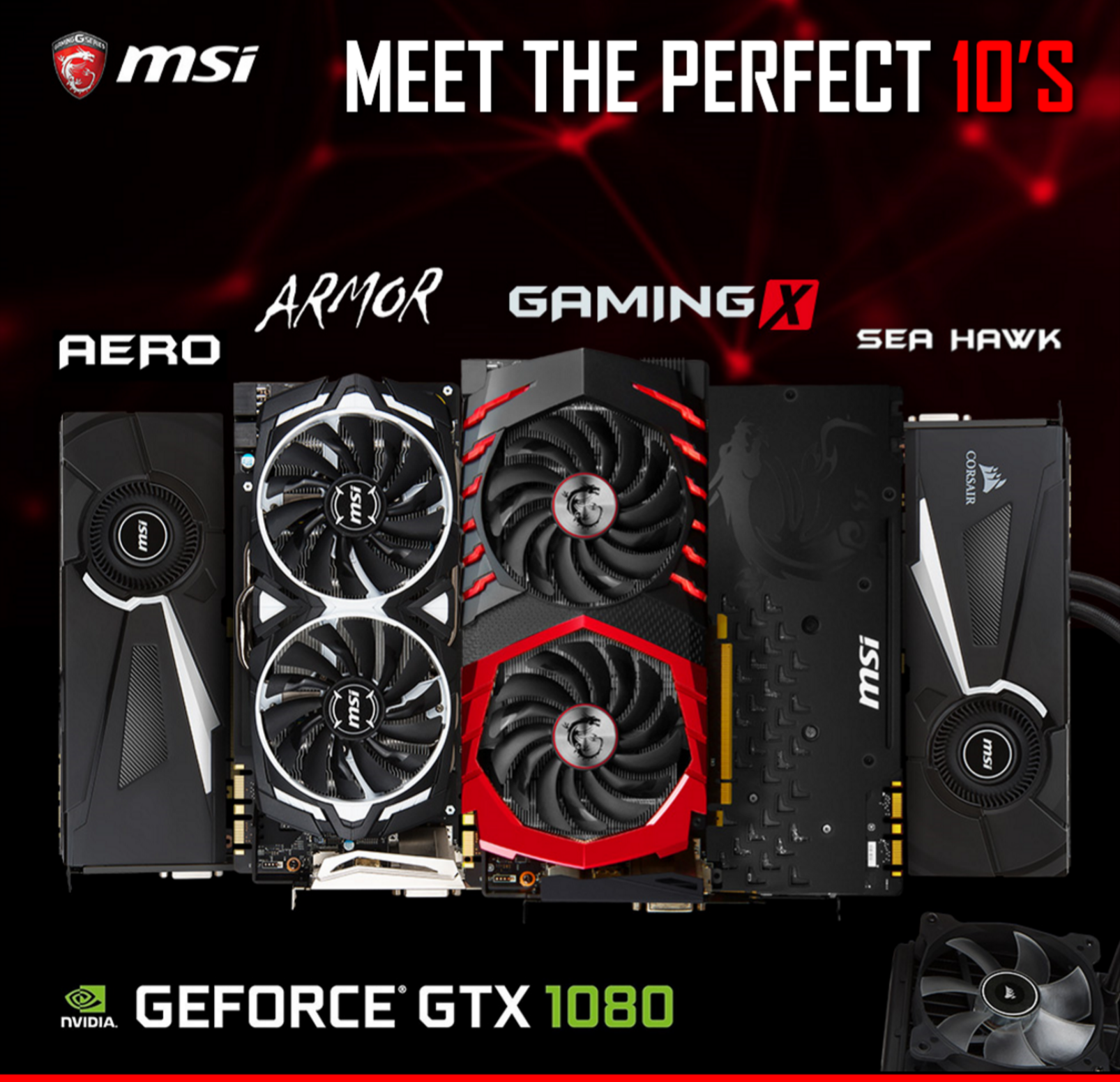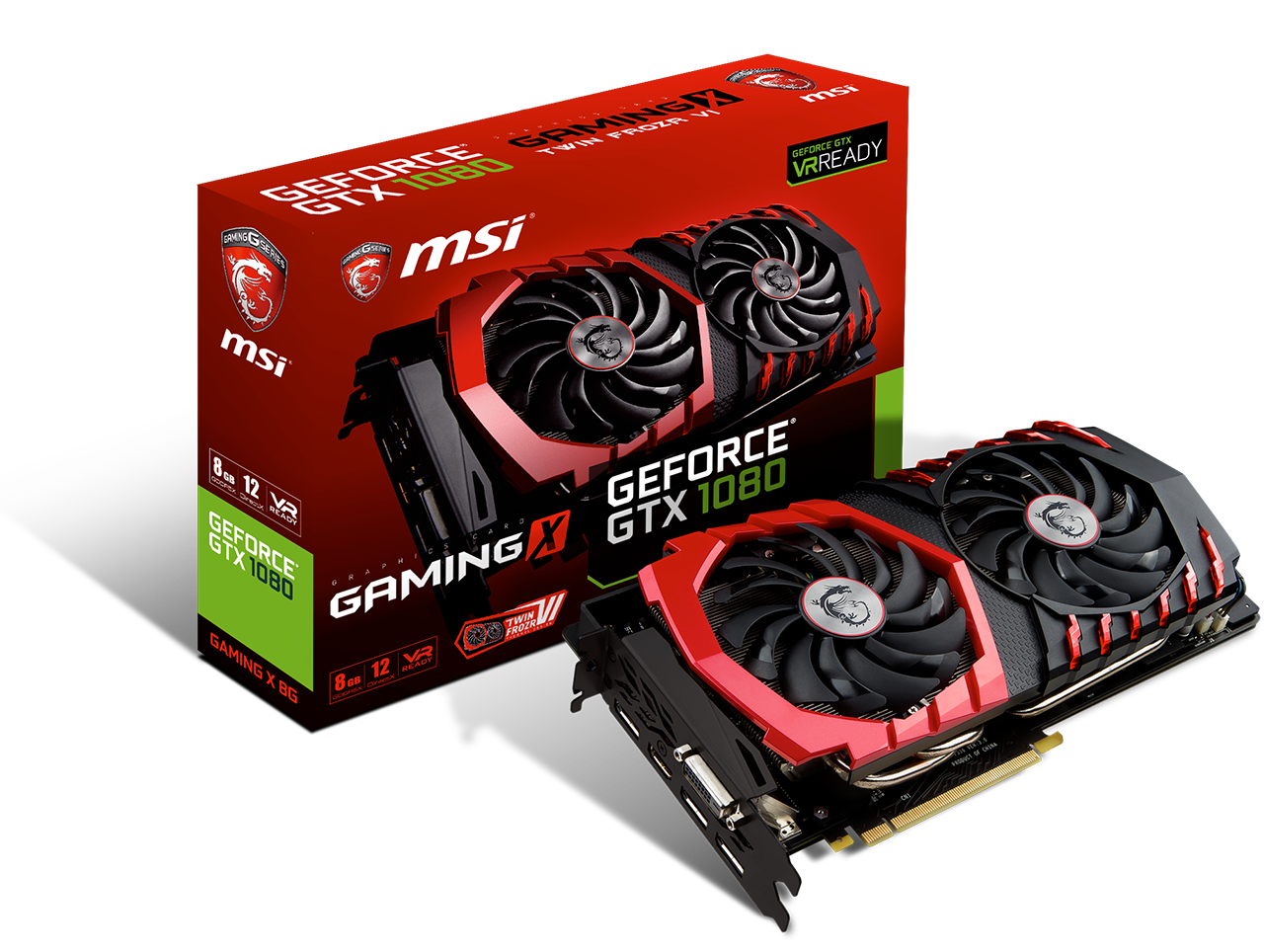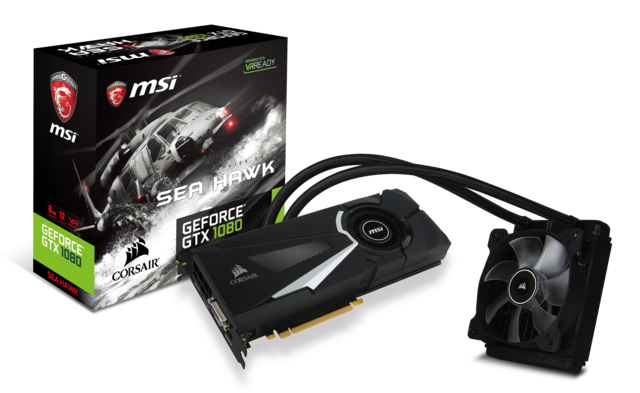MSI Drops Five Graphics Cards Into The GTX 1080 Arena (Updated)
Now that Nvidia has launched its Pascal graphics architecture, all of its board partners are scrambling to get new high-end GPUs out the door. MSI has a total of six of these cards to do battle against the likes of Asus, EVGA and Zotac.
The MSI GeForce GTX 1080 Gaming X 8G is the company’s flagship GTX 1080 graphics card. It uses essentially the same Twin Frozr VI thermal solution as MSI’s high-end 900-series graphics cards, and it has the same black metal backplate.
The GTX 1080 Gaming X 8G is clearly designed to be overclocked, as it has an aggregate 10-phase power design and includes an additional PCI-E power connector. Technically, Nvidia designed the GTX 1080 with a 180 W TDP, and going by the company’s specs, it requires just one eight-pin power connector. Between the eight-pin connector and the power from the motherboard, the GPU already has access to up to 225 W of power, but MSI opted to include a six-pin PCI-E power connector that brings the card’s total available power up to 300 W.
Clearly, the graphics card doesn’t need this much power, but extreme overclockers will find this additional power helpful when pushing the GPU to its limits.
MSI also has a water-cooled GTX 1080 that uses Corsair’s H55 Hydro cooler and a custom shroud. MSI didn’t make it clear if this is the same physical card as the GTX 1080 Gaming X 8G with a different cooler or if it is a different card entirely, and we have no information on its power design. As such, we are unable to compare these two GPUs in any way except to say one is water-cooled and one is not.
MSI didn’t disclose many details on the remaining four cards, either. Two of these GPUs are essentially the same; both use MSI’s Armor 2X thermal solution with two fans. The only difference between the two cards is that one has “OC” in its name. The OC card will almost certainly have a higher clock speed, but other than that, they are the same.
The last two cards are nearly identical to each other as well, again with the key difference being that one bears the “OC” label. These cards use MSI’s Aero Exhaust thermal solution, which is a single-fan cooler designed to vent out of the back of the PC case.
Get Tom's Hardware's best news and in-depth reviews, straight to your inbox.
Unfortunately, MSI did not disclose clock speeds on any of the graphics cards, so there is little information available for comparing against similar GPUs announced today.
There is currently no word on pricing or availability for these cards.
| MSI Nvidia GeForce GTX 1080 Product Lineup | ||||||
|---|---|---|---|---|---|---|
| GPU | GTX 1080 Gaming X 8G | GTX 1080 Sea Hawk | GTX 1080 Armor 8G OC | GTX 1080 Armor 8G | GTX 1080 Aero 8G OC | GTX 1080 Aero 8G |
| Core | GP104-400 | GP104-400 | GP104-400 | GP104-400 | GP104-400 | GP104-400 |
| Base Clock | 1607 MHz | 1707 MHz | 1657 MHz | 1607 MHz | 1632 MHz | 1607 MHz |
| Boost Clock | 1847 MHz | 1847 MHz | 1797 MHz | 1733 MHz | 1771 MHz | 1733 MHz |
| Memory | 8 GB GDDR5X | 8 GB GDDR5X | 8 GB GDDR5X | 8 GB GDDR5X | 8 GB GDDR5X | 8 GB GDDR5X |
| Memory Clock Speed | 10108 MHz | 10010 MHz | 10010 MHz | 10010 MHz | 10010 MHz | 10010 MHz |
| Thermal Solution | Twin Frozr VI | Corsair H55 Hydro | Armor 2X | Armor 2X | Aero Exhaust | Aero Exhaust |
| Backplate | Yes | Yes | No | No | No | No |
| LED | Yes (RGB) | Yes | No | No | Yes | Yes |
| Connectivity | 3 x Display PortHDMIDL-DVI-D | 3 x Display PortHDMIDL-DVI-D | 3 x Display PortHDMIDL-DVI-D | 3 x Display PortHDMIDL-DVI-D | 3 x Display PortHDMIDL-DVI-D | 3 x Display PortHDMIDL-DVI-D |
| Dimensions (L x W x H) | 279 x 140 x 42 mm | Card: 270 x 111 x 40 mmCooler: 151 x 120 x 52 mm | 279 x 140 x 37 mm | 279 x 140 x 37 mm | 269 x 111 x 35 mm | 269 x 111 x 35 mm |
Update, 5/27/16, 3:16pm PT: Updated table with clock speeds.
Follow Michael Justin Allen Sexton @EmperorSunLao. Follow us on Facebook, Google+, RSS, Twitter and YouTube.
-
turkey3_scratch There we go, blower-style cooler on the Aero without paying the hefty reference card prices.Reply -
Omar Bahaa For the missing information https://www.msi.com/Graphics-cards/#?category=NVIDIA-GeForce%3Csup%3E%26reg%3B%3C%2Fsup%3E-GTX-1080Reply -
JackNaylorPE So again, one would pay a premium for the the Sea Hawk because ?Reply
a) It has the same boost clock speed
b) It was slower memory
c) You can tell ya friends your card is water cooled -
rwinches The Sea Hawk is a Hybrid WC/Blower.Reply
Sounds like the best solution/option offered.
The Memory Speed is 10108 Mhz
https://www.msi.com/Graphics-card/GeForce-GTX-1080-SEA-HAWK.html#hero-overview -
JackNaylorPE Then either the chart is wrong, or I just don't get the math ?Reply
GTX 1080 Gaming X 8G = 10108 ... isn't that bigger ?
GTX 1080 Sea Hawk = 10010
And even if it's the same, why spend the extra $100 ?
Why is it the best solution, what does it bring to the table ? Are these new designs now cooling the memory and VRM? Does it allow increased performance ? It didn't on the 9xx series, it didn't on the 7xx series. And I say that sitting with 2 full cover water blocks, twin pumps, 5 x 1400mm of rad and 10 fans.
Yes my cards run cooler, but it has had no impact on GFX card performance. In fact air cooled builds we have done clocked higher. I built a custom loop system for silence, not increased performance.
My cards run at 44C ... so what ? the cards don't start throttling to 80C and the air cooled cards are topping out in the mid 60sn when OC'd to the max. So if if the cards not throttling when in full overclock, what will twin Sea Hawks bring to the table ? -
Jbowen867 Why do they have to make the hybrid card look like a freaking vhs tape??just a black box? Evga will look so much better I hopeReply -
David Dewis I'm interested to see the performance and sound levers of the blower cooler. I'm probably going to go for a blower style cooler for my elite 130 Gaming rig.Reply -
JackNaylorPE Check the reviews ... if ya look at 7xx and 9xx series, blower style coolers never reach the performance of their non blower brethren. Somehow or another folks have a conceptual idea that blowing all the air thru that small hole is a great but it just doesn't pan out in testing. Blowing some out thru the case slot and the rest of the air into the case and having the case fans remove that air results in lower GPU and VRM temps.Reply
I have also seen instances where peeps used a blower style cooler and had an equal number or less intake fanss than exhaust fans. Intake fans produce less air flow because of the inlet air restriction. So when there's more air being blown out then in, 'make up air' must come from somewhere ... and what happens is ... air exiting the blower cooler comes out the rear slot and is sucked right back in thru the rear case grille. Discussed this with several users and they adamantly have argued that it was not happening ... until I plugged in the fog machine at which point ya can see it happening.
-
turkey3_scratch I agree, I'd never get a blower style cooler. But some people were crying in defense of reference cards because of that style cooler, by which we now have non-reference blower cards, making the Founder's Edition more pointless.Reply -
MR B0CEPHUS I have MSI components, including a 980 ti, and love all of them. Still kicking butt. I'll be getting one of these babies.Reply


